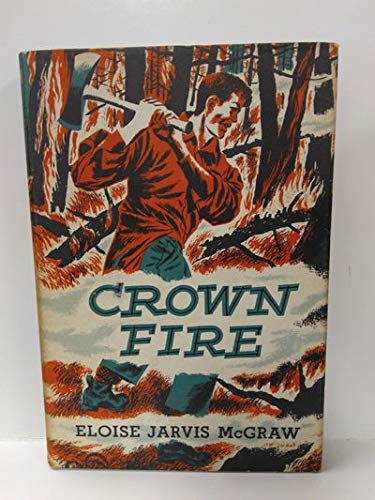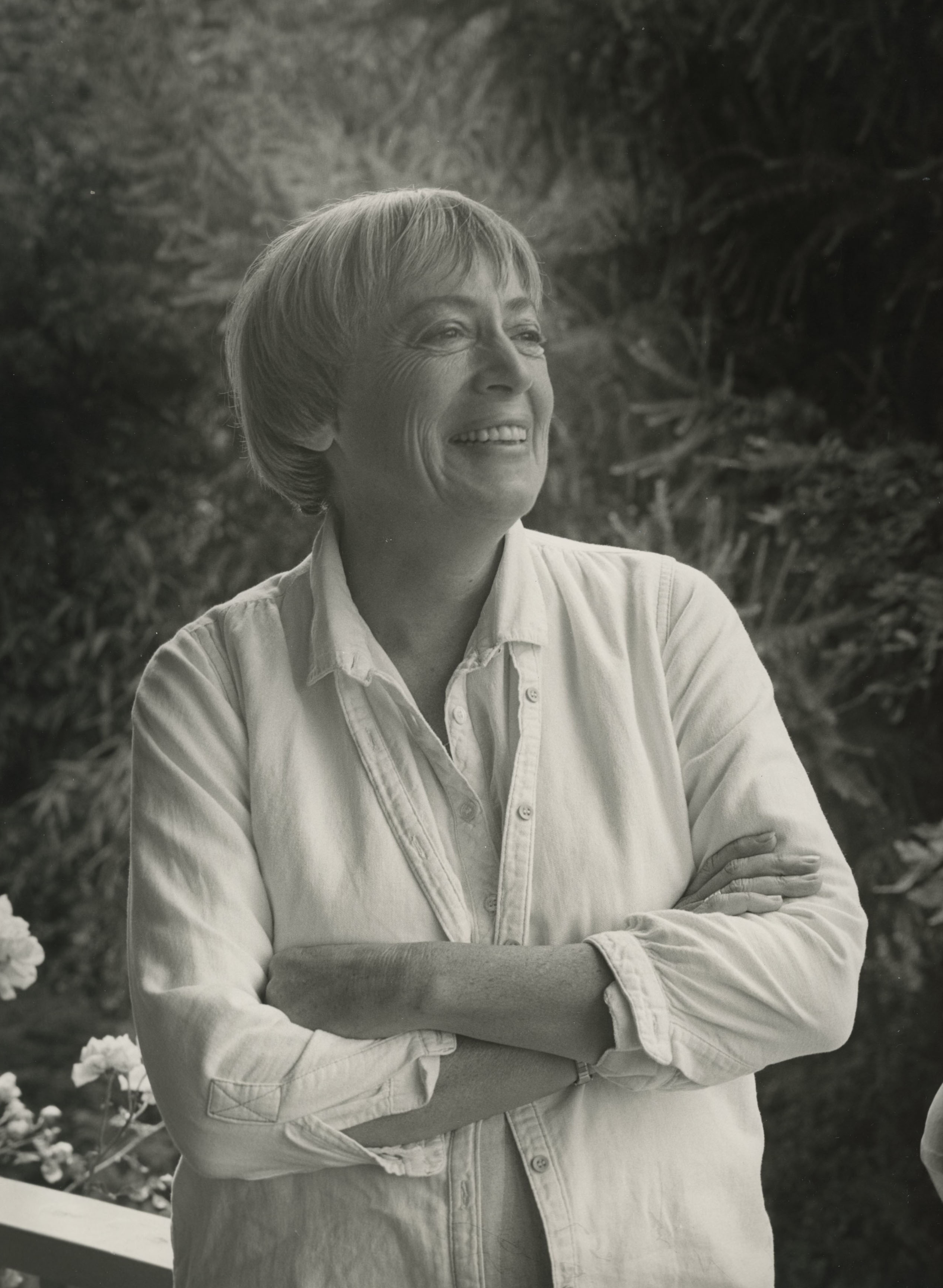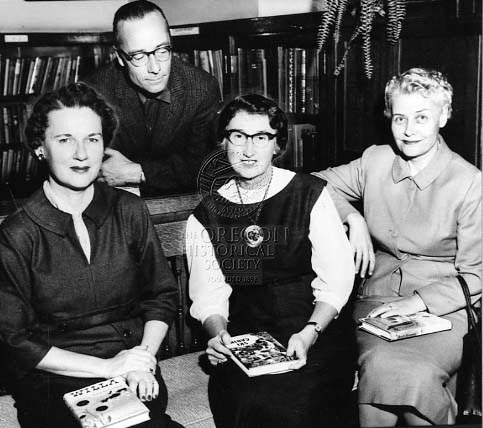When Literary Arts gives the Eloise Jarvis McGraw award to the best Oregon writer of young adult books each year, it is an acknowledgment of the state’s most decorated author in that genre, Eloise McGraw. Among her literary awards are three Newbery Honor Books, won in three different decades; an Edgar Award; a Golden Kite award; and a Lifetime Achievement Award from Literary Arts.
Eloise Jarvis Hamilton was born in Houston, Texas, on December 9, 1915, to Loy Hamilton and Genevieve Scoffern. She grew up in Oklahoma City, but she and her mother spent many summers with relatives in Oregon. During those trips, her father, a born storyteller, wrote stories for her instead of letters. Not surprisingly, Eloise began to write stories herself at an early age and ended up with her high school’s literary award at graduation. Then she took a class in oil painting and as a result dropped writing almost entirely for more than a decade.
Jarvis attended Principia College in Elsah, Illinois, and earned a bachelor’s degree in art in 1937, receiving the art award on graduation. She continued studying drawing and sculpture at Oklahoma and Colorado universities—and later at the Museum Art School in Portland—and earned money from portrait and mural commissions and from teaching oil painting at Oklahoma City University. She also dabbled in modern dance, puppetry, and radio and children’s theater for the Junior League and the YWCA. She married William Corbin McGraw, a newspaper man and later a children’s book author, in 1940. They lived in Cleveland, Oklahoma City, and San Diego while he pursued his newspaper career.
After a twelve-year absence from writing, Eloise McGraw returned to her first love. She published short stories in Cricket, Jack and Jill, Parents’ Magazine, and The Writer. Her first book, a story about a circus called Sawdust in His Shoes (1950), received critical acclaim from the Junior Literary Guild, the New York Times, and The Horn Book. Her second book, Crown Fire (1951), is a logging story set in Oregon’s forests. It was named an Honor Book in the Herald Tribune Children’s Book Festival; the German edition won the Deutsche Jugendbund-Sonderpreis.
In 1952, the McGraws bought a twenty-three-acre filbert orchard in Wilsonville and moved to Oregon. Moccasin Trail, which won the Newbery Honor Book award, appeared the same year. An absorbing story of the end of the mountain-man era and the settlements and farms in the nineteenth-century Northwest, Moccasin Trail demonstrates McGraw’s talent for developing convincing characters and her powers of observation, among the greatest strengths of her craft.
Following these books set in the Far West, McGraw’s interests shifted to Egyptology. She immersed herself in the works of John Wilson, Franklin Edgerton, and Herbert Winlock, which served as a springboard for Mara, Daughter of the Nile (1953). A work of fiction, the book presents in almost photographic detail the daily life of Egyptians in 1500 BCE. Her next book was an adult novel, Pharaoh (1958), which was followed by Golden Goblet (1961), the second of McGraw’s Newbery Honor Book winners.
McGraw’s careful research is evident again in Master Cornhill (1973), the story of an eleven-year-old orphan who lives through the Great Plague in 1665 and the Great Fire of London in 1666. The details in the book are from eyewitness accounts. The map of London accurately locates shops, inns, docks, stairs, St. Paul’s Cathedral, and bridges; and the book is peopled with historical figures. In the same vein is The Striped Ships (1991), which won the Oregon Book Award for Young Readers.
Seven of McGraw’s books focus on adventure, intrigue, and the illusion of reality, beginning with A Really Weird Summer (1977), which won the Edgar Award from the Mystery Writers of America. Other titles are Joel and the Great Merlini (1979), The Money Room (1981), Hideaway (1983), The Seventeenth Swap (1986), The Trouble with Jacob (1988), and Tangled Web (1993), a nominee for the Edgar Award.
The last of the twenty books published in McGraw’s lifetime was Moorchild (1996), her third Newbery Honor Book, an award she received forty-five years after the first one. The novel, about a half-fairy changeling struggling to find her place among humans, shows the anguish of not belonging, a persistent theme in McGraw’s writing. The author drew the haunting jacket design for this and three earlier books, combining her passions and talents.
With her daughter Lauren, a graphic artist, McGraw contributed three books to the fantastic wizardry of Oz begun by L. Frank Baum: Merry Go Round in Oz (1963), The Forbidden Fountain of Oz (1980), and The Rundelstone of Oz, which first appeared in Oz-story Magazine #6 on July 1, 2000, and was published in book edition posthumously in 2001 by Hungry Tiger Press. Eloise McGraw died in Portland on November 30, 2000, of complications from cancer.
-
![]()
Crown Fire, by Eloise Jarvis McGraw.
Courtesy Coward-McCann
-
![]()
Moccasin Trail, by Eloise Jarvis McGraw.
Courtesy Puffin Newbery Library
Related Entries
-
![Eric A. Kimmel (1946–)]()
Eric A. Kimmel (1946–)
Eric A. Kimmel is Oregon’s most prolific writer of children’s and young…
-
![Oregon Literature (1920-2010)]()
Oregon Literature (1920-2010)
The joint appearance in 1927 of the controversial pamphlet Status Rerum…
-
![William Corbin (1916-1999)]()
William Corbin (1916-1999)
William Corbin McGraw and Eloise Jarvis McGraw, husband and wife, were …
Map This on the Oregon History WayFinder
The Oregon History Wayfinder is an interactive map that identifies significant places, people, and events in Oregon history.
Further Reading
“Eloise Jarvis McGraw.” In Something about the Author Autobiography Series, Vol 6. Detroit: Gale Research Inc., 1988, 179–201.
Hardt, Ulrich H. “How Sawdust and Other Trails Lead to Egypt, England, and Oz: Profile of Eloise Jarvis McGraw.” Oregon English Journal 20 (Spring 1998): 51-58, 92.
McGraw, Eloise Jarvis. Techniques of Fiction Writing. Boston: The Writer, Inc., 1959.
McGraw, Lauren Lynn. “Eloise Jarvis McGraw, 1915–2000.” The Baum Bugle 45 (Autumn 2001): 5-7.





